Ancient Quotations
Biblical Verses Highlighting Love Through the Ages

Throughout history, biblical verses have eloquently showcased the timeless strength of love. From the captivating Garden of Eden to the life-changing Exodus, love has been intricately integrated into the fabric of human existence.
The wisdom literature, the Psalms, and even the Book of Revelation all bear witness to the profound depths of love’s presence. As we delve into the writings of the early Church Fathers, the mystical insights of the medieval Christian mystics, and the modern interpretations of today, we discover a timeless truth: love transcends time, culture, and interpretation.
In this exploration of biblical verses highlighting love through the ages, we invite you to join us on a journey of discovery and understanding, as we uncover the profound significance of love in the sacred scriptures.
Key Takeaways
- Love has been a prominent theme throughout the Old Testament, starting with the love between Adam and Eve in the Garden of Eden.
- Cultural influences played a significant role in shaping the understanding of love during the Age of Patriarchs.
- Love is demonstrated in the Exodus story, particularly in God’s love for His people and their love and loyalty towards Him.
- Love is a central theme in the New Testament, with a focus on love in the teachings of Jesus, the letters of Paul, and the early Christian community.
Love in the Garden of Eden
As we delve into the topic of ‘Love in the Garden of Eden’, it becomes evident that God’s creation of Adam and Eve symbolizes the very essence of divine love. The Garden of Eden, often described as a paradise, served as the backdrop for the first expression of love between human beings.
This idyllic setting, filled with lush vegetation and abundant fruit, provided the perfect environment for love to flourish. In this garden paradise, Adam and Eve experienced a love that was pure and untainted. They were created to complement and complete one another, forming a divine union that reflected God’s perfect love. Their love was characterized by trust, intimacy, and a deep sense of connection. They walked together in harmony, sharing in the beauty and abundance of their surroundings.
However, this paradise wasn’t without its challenges. God had placed a single restriction upon them – the forbidden fruit from the tree of knowledge. This forbidden love became a test of their faith and obedience. Sadly, they succumbed to temptation and disobeyed God’s command, bringing about the fall of humanity.
As we transition into the subsequent section about ‘love in the age of patriarchs’, we see how the consequences of Adam and Eve’s actions impacted future generations. Despite the brokenness that entered the world, love continued to be a central theme in the lives of the patriarchs, offering glimpses of God’s enduring love for His creation.
Love in the Age of Patriarchs
In exploring the theme of love in the age of patriarchs, we encounter a complex interplay of dynamics.
Patriarchal love is characterized by the roles and responsibilities assigned to each member of the family unit. Love is seen as a covenant commitment, grounded in loyalty, sacrifice, and mutual respect.
Additionally, cultural influences on love can’t be ignored, as societal norms and expectations shape the expression and understanding of love within patriarchal contexts.
Patriarchal Love Dynamics
During the Age of Patriarchs, love dynamics revolved around hierarchical relationships within the family unit. Power dynamics and gender roles played a significant role in shaping these dynamics. Patriarchal love was characterized by the authority of the male figure, who held dominion over the household. This authority extended to decision-making, provision, and protection. Women were expected to be submissive and obedient to their husbands, with their primary role being that of a wife and mother. To illustrate these dynamics, let us examine the following table:
| Power Dynamics | Gender Roles |
|---|---|
| Male authority | Female submission |
| Decision-making | Domestic duties |
| Provider | Homemaker |
| Protector | Nurturer |
| Head of the family | Supportive role |
These dynamics were deeply embedded in the social and cultural fabric of the time, reflecting the prevailing beliefs and norms. However, it is important to note that these dynamics are not universally applicable or endorsed in contemporary society. Instead, we now explore how the concept of love evolved from patriarchal love dynamics to a covenant commitment.
Love as Covenant Commitment
Throughout the Age of Patriarchs, love was experienced as a deep, enduring covenant commitment that bound families together. Love as commitment wasn’t merely an emotional or romantic feeling, but a solemn promise to uphold and honor the covenant between God and His people. This covenant commitment was seen in the relationships between spouses, parents and children, and among extended family members.
In patriarchal society, love wasn’t solely based on personal preference or temporary affection, but on a deep sense of duty and responsibility. It was a commitment to care for, protect, and provide for one’s family. This love as covenant was rooted in the belief that God had established the family unit as the foundation of society, and that fulfilling one’s covenant obligations was essential for the well-being and flourishing of the entire community.
The patriarchs, such as Abraham, Isaac, and Jacob, exemplified this love as covenant commitment in their relationships. They demonstrated unwavering loyalty, sacrificial devotion, and steadfast faithfulness to their spouses and offspring. Their love wasn’t conditional or fleeting, but enduring and unbreakable, reflecting the enduring nature of the covenant between God and His people.
Cultural Influences on Love
Our understanding of love in the Age of Patriarchs was greatly influenced by the cultural norms and values of that time. Gender roles played a significant role in shaping the concept of love during this period. Men were expected to be the providers and protectors, while women were seen as nurturers and homemakers. These roles created a power dynamic where men held authority over women, often dictating the terms of love and marriage.
Romantic ideals in the Age of Patriarchs were also influenced by cultural norms. Marriages were often arranged, based on factors such as social status, family alliances, and economic considerations, rather than personal compatibility or romantic love. Love was viewed as a duty and commitment to one’s family and community, rather than an individualistic pursuit of personal happiness.
Table:
| Cultural Influences on Love in the Age of Patriarchs |
|---|
| Gender Roles |
| Romantic Ideals |
| Duty and Commitment |
Love in the Exodus Story
In the Exodus story, we witness numerous acts of unwavering love displayed by God towards His people. Love in liberation is evident as God hears the cries of the Israelites in their bondage and sets them free from the oppressive hand of Pharaoh. Through the ten plagues, God demonstrates His love by showing His power and might, ultimately leading to the liberation of His people from slavery.
Love in redemption is highlighted as God leads the Israelites through the Red Sea, delivering them from the pursuing Egyptian army. In this act of redemption, God displays His love by protecting His people and ensuring their safety. He provides for them in the wilderness, giving them manna and water, showing His continuous care and provision.

God’s love in the Exodus story isn’t only seen through His actions but also through His words. He makes a covenant with His people, promising to be their God and to dwell among them. This covenant demonstrates His desire for a relationship with His people, a relationship grounded in love and faithfulness.
Love in the Wisdom Literature
Exploring the wisdom literature reveals the profound insights on love that guide and inspire us. Within this genre of biblical texts, love is portrayed in a way that transcends time and speaks to the depths of our human experience. In modern relationships, we can draw wisdom from these ancient writings to navigate the complexities of love and enrich our connections with others.
In the wisdom literature, love is depicted as a transformative force that brings about positive change and growth. It isn’t merely an emotion or a fleeting feeling, but a conscious choice and commitment to care for others. This understanding of love in contemporary literature aligns with the wisdom literature’s emphasis on the importance of compassion, kindness, and empathy in our relationships.
The wisdom literature also highlights the significance of love in fostering harmony and unity within communities. It teaches us the value of seeking understanding and resolving conflicts through love rather than power or dominance. Love in modern relationships can be nurtured by embracing this wisdom and striving for peaceful coexistence.
Moreover, the wisdom literature offers practical advice on love, urging us to be patient, forgiving, and slow to anger. It reminds us that love requires effort and perseverance, and that it isn’t always easy. Love in contemporary literature often echoes this sentiment, emphasizing the need for commitment and dedication in our relationships.
Love in the Psalms
Drawing from the Psalms, we find profound expressions of love that inspire and uplift our spirits. The Psalms are a collection of poetic prayers and songs that are attributed to King David and other psalmists. In these sacred texts, love is depicted in various ways, both in the context of contemporary worship and in the psalmist’s personal life.
Love in contemporary worship is a prominent theme in the Psalms. The psalmists express their deep love and devotion for God, praising His steadfast love and faithfulness. They acknowledge God’s love as the source of their strength and salvation, declaring their love for Him with heartfelt sincerity. The psalmists also invite others to join in this expression of love, encouraging communal worship and adoration.
Moreover, the Psalms offer glimpses into the psalmist’s personal life and their intimate relationship with God. The psalmists openly share their joys, sorrows, and struggles, seeking solace and guidance from God’s love. They find comfort in knowing that God’s love is never-failing and unconditional. Through their personal experiences, the psalmists teach us that love can be found even in the midst of pain and hardship.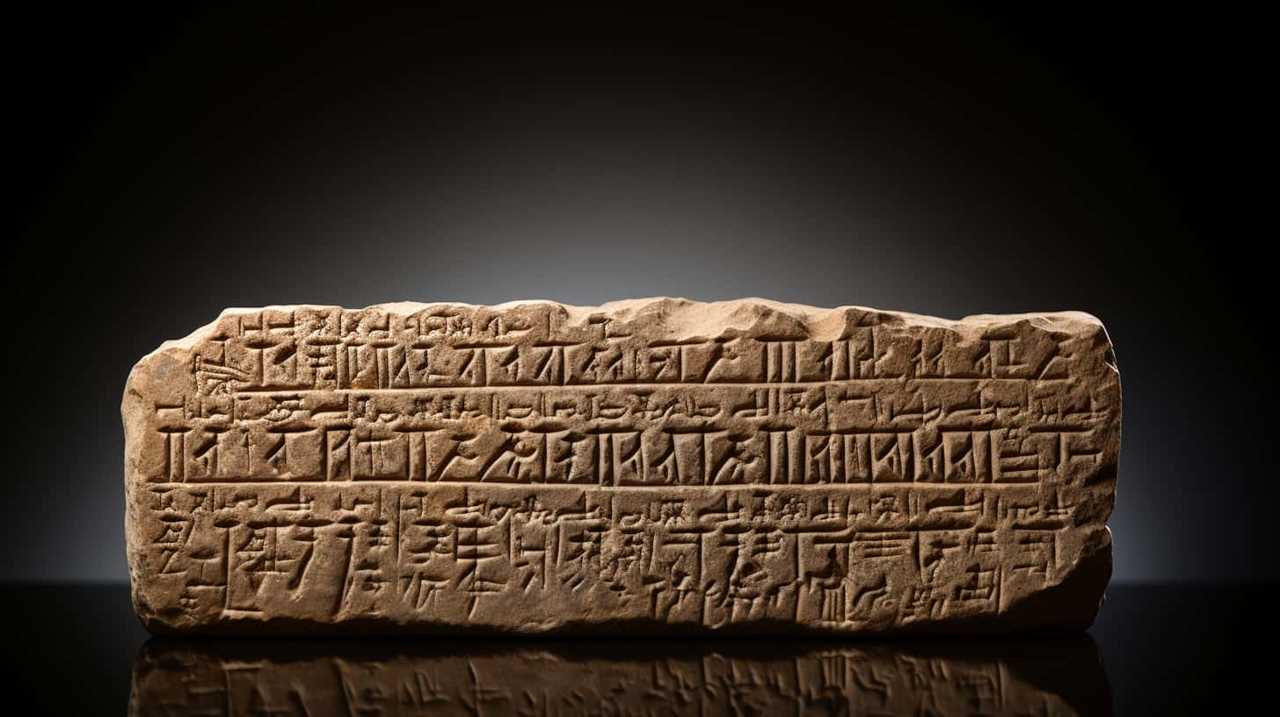
Love in the Prophets
Continuing our exploration of love in biblical texts, let’s now delve into the prophets, where love is revealed through their passionate messages of divine compassion and redemption. In the Prophets, we witness love in action, as the prophets embody and proclaim God’s love for humanity.
Here are some key insights into love’s role in the prophetic texts:
- Prophetic love dynamics: The prophets demonstrate a profound understanding of the complexities of love. They reveal that love isn’t just a sentimental feeling, but a transformative force that calls for justice, mercy, and righteousness.
- Love’s role in social justice: The prophets emphasize the inseparable connection between love and social justice. They call for the eradication of oppression, the care for the marginalized, and the restoration of a just society. Love in the prophetic texts compels individuals and communities to actively pursue justice and work towards societal transformation.
- Divine love as a source of hope: The prophets remind us of God’s unending love and faithfulness, even in the midst of despair and suffering. Their messages of hope and redemption reveal that love is a powerful force that can heal brokenness and bring about restoration.
- Love as a call to repentance: The prophets challenge individuals and societies to turn away from their sinful ways and return to God’s love. They emphasize that love requires a response, a turning towards righteousness and a rejection of injustice.
- Love’s transformative power: The prophets show us that love has the power to bring about personal and societal transformation. Through their passionate messages, they inspire us to embody love in our actions and to work towards creating a more just and compassionate world.
As we transition into the subsequent section about love in the New Testament Gospels, we’ll see how the prophetic themes of love find their fulfillment in the life and teachings of Jesus Christ.
Love in the New Testament Gospels
In the New Testament Gospels, we encounter two significant aspects of love: love as self-sacrifice and love for enemies.
The concept of love as self-sacrifice is exemplified by Jesus’ ultimate act of love on the cross, where he willingly laid down his life for the redemption of humanity.
Additionally, Jesus teaches us to love our enemies, challenging conventional notions of love and expanding the boundaries of compassion and forgiveness.
These powerful teachings on love in the New Testament Gospels continue to inspire and guide believers in their pursuit of love and compassion.
Love as Self-Sacrifice
We can find numerous biblical verses in the New Testament Gospels that exemplify love as self-sacrifice. The concept of selflessness and altruistic love is central to the teachings of Jesus Christ and is highlighted in various passages.
- Matthew 16:24: ‘Then Jesus said to his disciples, ‘Whoever wants to be my disciple must deny themselves and take up their cross and follow me.”
- Mark 10:45: ‘For even the Son of Man didn’t come to be served, but to serve, and to give his life as a ransom for many.’
- Luke 9:23: ‘Then he said to them all: ‘Whoever wants to be my disciple must deny themselves and take up their cross daily and follow me.”
- John 15:13: ‘Greater love has no one than this: to lay down one’s life for one’s friends.’
- Luke 22:42: ‘Father, if you’re willing, take this cup from me; yet not my will, but yours be done.’
These verses emphasize the sacrificial nature of love, urging believers to prioritize the needs of others above their own. Jesus, as the ultimate example of self-sacrifice, willingly gave up his life for the redemption of humanity. This selflessness serves as a model for followers of Christ, encouraging them to love sacrificially and selflessly.
Love for Enemies
Our encounters with biblical verses in the New Testament Gospels reveal the profound call to love even our enemies. Jesus teaches us that love and forgiveness aren’t limited to those who are close to us or share our beliefs, but extends to those who oppose us or seek to harm us.
In Matthew 5:44, Jesus says, ‘But I tell you, love your enemies and pray for those who persecute you.’ This radical command challenges our natural instincts and societal norms. It compels us to see our enemies through the lens of love, seeking their good and desiring their reconciliation.
Through loving our enemies, we participate in the transformative power of love, breaking the cycle of hatred and violence, and embodying the essence of Christ’s teachings.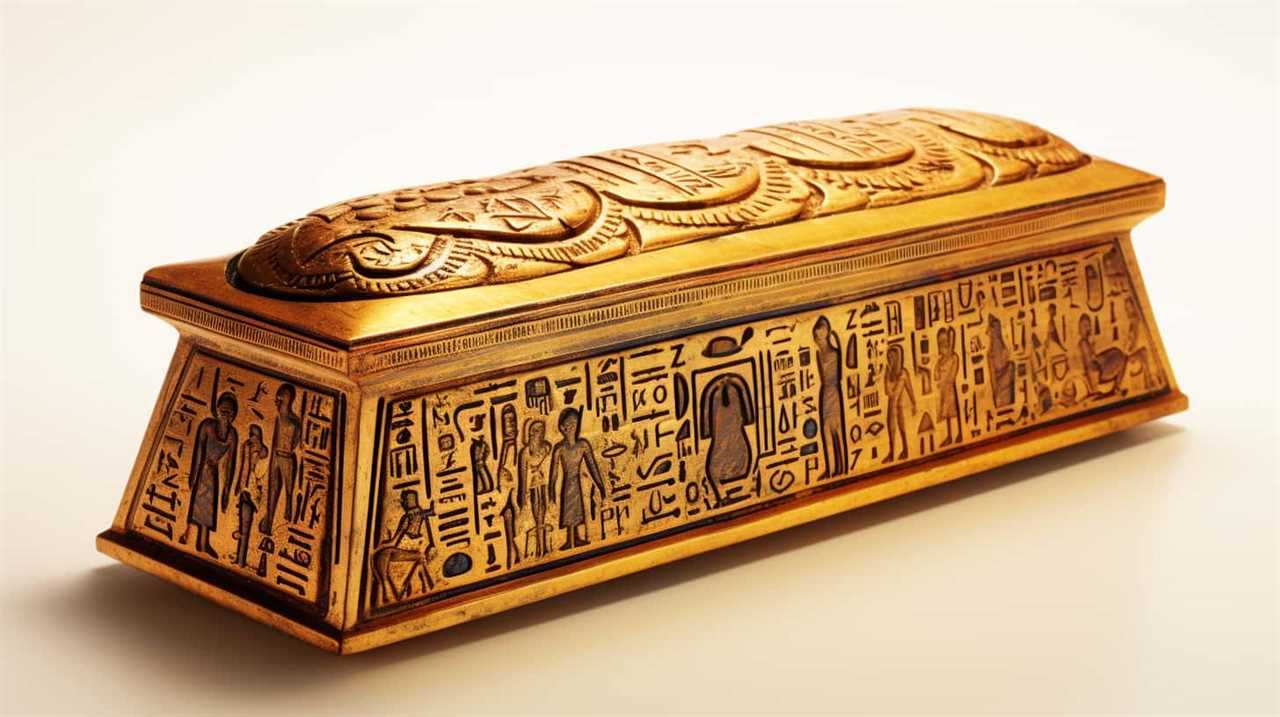
Love in the Epistles of Paul
Throughout the Epistles of Paul, we’re presented with a profound and transformative understanding of love that surpasses all boundaries and expectations. Pauline love, as expressed in his letters to the early Christian communities, is a central theme that resonates with believers to this day.
Here are five key aspects of love in the Epistles of Paul:
- Unconditional Love: Paul emphasizes the unconditional nature of love, teaching that it should be extended to all people, regardless of their background or actions.
- Sacrificial Love: Paul encourages believers to emulate Christ’s sacrificial love, putting others before themselves and willingly giving up their own desires for the sake of others.
- Active Love: Paul emphasizes that love isn’t merely a feeling, but an action. He calls upon believers to actively demonstrate their love through acts of kindness, compassion, and service.
- Love as the Fulfillment of the Law: Paul teaches that love is the fulfillment of God’s law, as it encapsulates all the commandments. Love becomes the guiding principle for believers, shaping their actions and relationships.
- Love as the Bond of Unity: Paul highlights the power of love in fostering unity among believers. He urges them to bear with one another in love, promoting harmony and reconciliation within the Christian community.
As we delve into the concept of love in the early Christian community, we’ll explore how these teachings of Paul were put into practice and how they influenced the growth and development of the early Church.
Love in the Early Christian Community
As we explore the theme of love in the early Christian community, we’re confronted with the transformative power that love holds. Love has the ability to change lives, not only on an individual level, but also within the community as a whole.
It’s through sacrificial love that the early Christians were able to make a lasting impact, putting the needs of others above their own. This sacrificial love served as the foundation for the early Christian community, fostering unity and a sense of belonging among its members.
Love’s Transformative Power
Love has always played a transformative role within the early Christian community, consistently shaping our beliefs, actions, and relationships. The power of love to heal and bring about positive change can’t be overstated.
In the early Christian community, this transformative power of love was evident in various ways:
- Love transformed individuals: The love of Christ, demonstrated through the sacrificial love of believers, had the power to change hearts and minds. It brought about a deep sense of forgiveness, reconciliation, and inner transformation.
- Love transformed communities: Love created a sense of unity and solidarity among believers. It transcended social barriers and brought people together in a community marked by love, compassion, and mutual support.
- Love transformed relationships: Love fostered healthy and authentic relationships among believers. It encouraged selflessness, empathy, and a genuine desire to care for one another.
- Love transformed actions: Love motivated believers to act justly, show mercy, and serve others selflessly. It inspired them to live out their faith in practical ways, meeting the needs of the marginalized and oppressed.
- Love transformed the world: The transformative power of love within the early Christian community had a ripple effect beyond its boundaries. It challenged societal norms, confronted injustice, and brought about positive change in the wider world.
Sacrificial Love’s Impact
In the early Christian community, the impact of sacrificial love was evident in its ability to transform individuals, communities, relationships, actions, and the world at large. Sacrificial love’s significance lay in its selflessness and willingness to put others’ needs above one’s own. This kind of love was exemplified by Jesus Christ, who willingly sacrificed himself for the salvation of humanity. This act of sacrificial love not only demonstrated God’s immense love for humanity but also served as a powerful example for the early Christian community to follow.
Love’s impact on relationships within this community was profound, as sacrificial love fostered a spirit of unity, compassion, and selflessness among its members. It created a sense of interconnectedness and mutual support, strengthening the bonds of fellowship and promoting a sense of shared purpose. Through sacrificial love, the early Christian community was able to exemplify the teachings of Christ and create a transformative impact on the world around them.
This understanding of sacrificial love and its impact on relationships laid the foundation for the subsequent section on ‘love as community foundation’.
Love as Community Foundation
Within the early Christian community, we built our foundation of love upon a deep sense of interconnectedness and mutual support. Love served as a communal bond that held us together and guided our actions towards one another.
This love wasn’t simply a sentimental feeling, but a deliberate choice to prioritize the well-being of the community above our own individual interests. It fostered an environment of trust, compassion, and unity, enabling us to overcome differences and work towards a common purpose.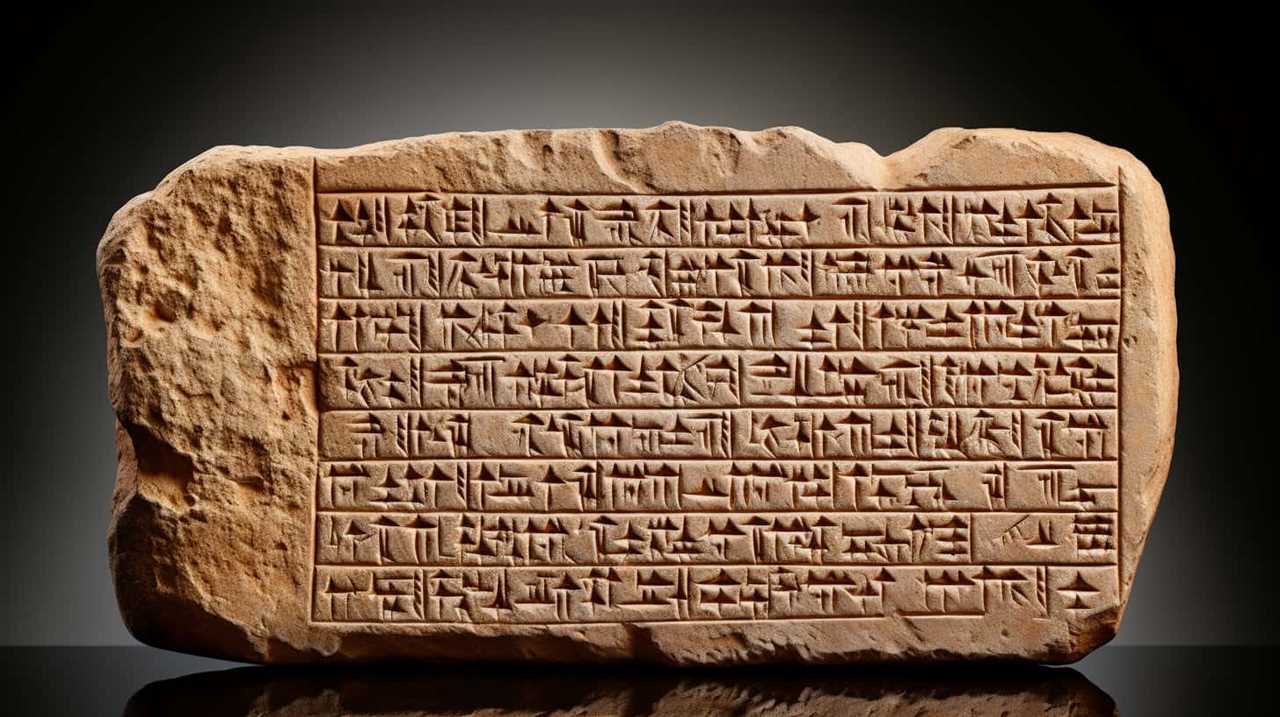
Love in the early Christian community was marked by selflessness, forgiveness, and a commitment to serve one another. Today, as we reflect on the example set by our early Christian ancestors, we’re reminded of the transformative power of love in contemporary society.
It challenges us to build communities that are rooted in love and characterized by solidarity, empathy, and genuine care for one another.
Love in the Acts of the Apostles
Exploring the bond between believers, the Acts of the Apostles vividly portrays the selflessness and compassion found within the early Christian community. Love permeates every aspect of their lives, evident in their missionary journeys and in the face of early church persecution.
In the Acts of the Apostles, love is seen in the missionary journeys undertaken by the apostles. They ventured into unknown territories, spreading the message of Christ’s love to all they encountered. Their love for God and for their fellow humans drove them to share the good news, even in the face of great opposition and danger. This love wasn’t limited to their own communities but extended to all people, regardless of ethnicity or social status.
Furthermore, love in the Acts of the Apostles is exemplified through the early church’s response to persecution. Despite facing intense hostility and persecution, the early Christians remained steadfast in their love for one another. They supported and cared for each other, sharing their resources and ensuring that no one among them was in need. This sacrificial love stood as a powerful witness to the transformative power of Christ’s love.
Transitioning into the subsequent section about ‘love in the letters to the seven churches,’ the Acts of the Apostles provides a foundation for understanding the importance of love within the early Christian community. It sets the stage for the letters to the seven churches, where love is further explored and emphasized as a vital component of the Christian faith.
Love in the Letters to the Seven Churches
Transitioning from the Acts of the Apostles, we witness the significance of love within the early Christian community through the letters addressed to the seven churches. These letters, written by the apostle John and recorded in the book of Revelation, provide valuable insights into the role of love in both church unity and spiritual growth.
- Love and Church Unity: The letters emphasize the importance of love in maintaining unity among believers. John encourages the churches to love one another, to forgive each other, and to bear with one another’s weaknesses. This love is meant to create a strong bond of unity within the body of Christ.
- Love and Spiritual Growth: Love is also seen as crucial for spiritual growth. John reminds the churches that love is the mark of a true disciple of Christ. By loving one another, believers can grow in their understanding of God’s love and reflect it to the world. Love is the catalyst for spiritual maturity and transformation.
- Love as a Commandment: The letters reaffirm the commandment to love one another. Love isn’t merely a suggestion but a commandment from God. It’s a duty and a responsibility for every believer to love their fellow brothers and sisters in Christ.
- Love as a Test of Authenticity: Love is presented as a test of authenticity. Genuine love for others is evidence of a true and sincere faith. The letters warn against a love that’s merely superficial or hypocritical. Love must be genuine and heartfelt.
- Love as the Motive for Service: Love is the motive for service in the church. John encourages the churches to love and serve one another, using their spiritual gifts to build up the body of Christ. Love is the driving force behind acts of kindness, compassion, and selflessness within the Christian community.
Love in the Book of Revelation
Continuing our exploration of love within the biblical context, let’s delve into the book of Revelation and uncover the significance of love in its prophetic messages.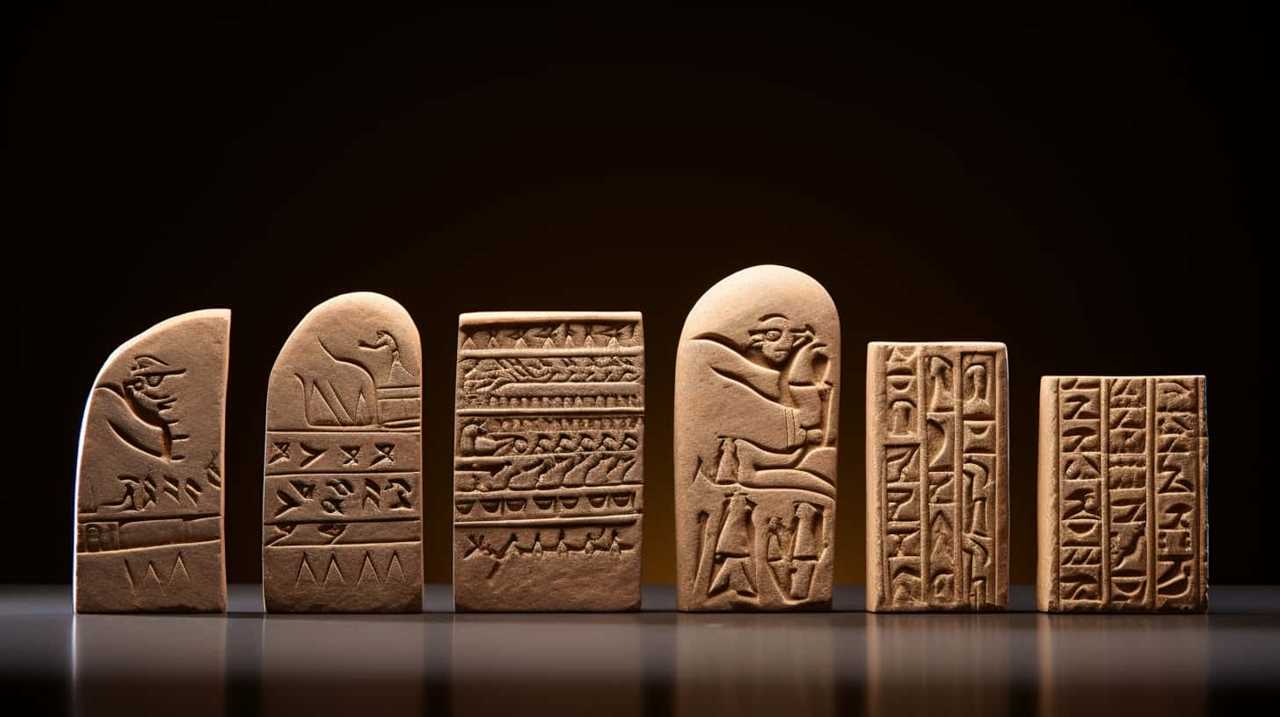
In the book of Revelation, love is portrayed as a powerful force that transcends the trials and tribulations of the end times. It’s depicted as a divine intervention, a source of hope and comfort amidst chaos and destruction.
The book of Revelation describes a world engulfed in turmoil, with wars, plagues, and natural disasters. In the midst of this chaos, love emerges as a beacon of light. It’s through love that believers find solace and strength to persevere. The Apostle John, the author of Revelation, emphasizes the importance of love in the face of adversity, urging the churches to remain faithful and steadfast in their love for God and one another.
Love in the book of Revelation isn’t just a sentimental feeling, but a powerful force that empowers believers to overcome evil. It’s through love that believers are able to resist the allure of worldly temptations and remain true to their faith. Love is depicted as a transformative force, capable of redeeming and restoring even the most broken of individuals.
Love in the Early Church Fathers
As we delve into the topic of love in the Early Church Fathers, it becomes evident that their teachings emphasized the transformative power of love in the Christian faith. The Early Church Fathers were influential theologians and leaders of the early Christian Church who lived in the first centuries after Christ. They played a crucial role in shaping Christian theology and guiding the development of the Church.
In their writings, the Early Church Fathers explored various aspects of love, considering its significance in the lives of believers and its impact on the Christian community. Here are some key insights from their teachings:
- Love as the foundation of Christian life: The Early Church Fathers emphasized that love is the cornerstone of the Christian faith. They believed that love should be the driving force behind all actions and interactions among believers.
- Patriarchal love dynamics: It’s essential to understand that the Early Church Fathers lived in a patriarchal society, where gender roles were clearly defined. Their teachings on love often reflected this cultural context, emphasizing the importance of love within hierarchical structures.
- Cultural influences on love: The Early Church Fathers were also influenced by the cultural norms and philosophical ideas of their time. Their writings on love reflect the fusion of Christian teachings with Greco-Roman philosophy and ethics.
- Love as transformative: The Early Church Fathers saw love as a transformative force that had the power to change individuals and society. They believed that love could overcome sin, heal divisions, and bring about unity and harmony within the Church.
- Love as self-giving: The Early Church Fathers emphasized the sacrificial nature of love, encouraging believers to imitate Christ’s selfless love for humanity. They taught that true love involves self-giving and self-sacrifice for the sake of others.
Love in the Medieval Christian Mystics
Let’s explore how love was understood and expressed by the Medieval Christian Mystics. During the medieval period, mysticism flourished as a spiritual movement within Christianity. The medieval mystics sought a direct and intimate union with God, often described as the mystical marriage or union of the soul with the divine. Divine love was at the heart of their spiritual experiences and writings.
The medieval mystics, such as Julian of Norwich, Meister Eckhart, and Saint John of the Cross, emphasized the transformative power of divine love. They believed that through deep contemplation, prayer, and surrender to God’s will, individuals could experience a profound union with the divine. This divine love was seen as a spiritual journey that transcended the limitations of human understanding and language.
The mystics understood divine love as an all-encompassing force that permeates every aspect of existence. It wasn’t merely a feeling or emotion, but a transformative and unifying power that could lead to spiritual enlightenment and union with God. Divine love was seen as the ultimate goal of human existence, and the mystics sought to cultivate this love within themselves and others through acts of compassion, selflessness, and devotion.
In the writings of the medieval mystics, we find rich and profound insights into the nature of divine love. They remind us that love isn’t limited to human relationships, but extends to the very heart of our spiritual journey. Through their teachings and experiences, the medieval mystics invite us to explore the depths of divine love and to seek a deeper connection with the divine in our own lives.
Love in Modern Interpretations
Moving forward, we delve into how love has been interpreted in modern times by exploring its various dimensions and applications. Modern interpretations of love have been greatly influenced by societal changes and evolving expectations. In contemporary culture, love has taken on new forms and expressions. Here are five key aspects of love in modern interpretations:
- Digital Dating: With the rise of technology and social media, dating has shifted to the digital realm. Online platforms and dating apps have revolutionized the way people meet and form romantic connections.
- Non-Traditional Relationships: Modern interpretations of love embrace a wider range of relationship dynamics. Non-traditional relationships such as polyamory, open relationships, and same-sex partnerships are increasingly accepted and celebrated.
- Self-Love and Empowerment: There’s a growing emphasis on self-love and empowerment in modern interpretations of love. People are encouraged to prioritize their own happiness and well-being, recognizing that a healthy relationship with oneself is essential for nurturing and sustaining healthy relationships with others.
- Intersectionality and Inclusivity: Love in modern interpretations is more inclusive and intersectional, recognizing and valuing the diversity of experiences, identities, and perspectives. It seeks to break down barriers and promote equality and understanding.
- Emotional Intelligence and Communication: Modern interpretations of love highlight the importance of emotional intelligence and effective communication in relationships. People are encouraged to express their feelings, needs, and desires openly and honestly, fostering deeper connections and understanding.
Frequently Asked Questions
How Does the Concept of Love in the Garden of Eden Relate to the Concept of Love in the New Testament Gospels?
In comparing the concept of love in the Garden of Eden to the New Testament gospels, we observe both similarities and differences. Love is consistently portrayed as the foundation of relationships in biblical narratives and teachings.
What Are the Different Forms of Love Highlighted in the Wisdom Literature?
In the wisdom literature of the Old Testament, various forms of love are illuminated. Examples include the love of wisdom, the love of God’s law, and the love of others. These portrayals offer insights into the multifaceted nature of love.
How Does Love in the Exodus Story Differ From Love in the Letters to the Seven Churches?
Love in the exodus story can be seen as love as liberation, where God’s love frees the Israelites from bondage. In contrast, love in the letters to the seven churches focuses on love as community building, urging believers to love one another.
What Role Does Love Play in the Early Christian Community?
Love played a pivotal role in the early Christian community, fostering unity and inspiring acts of service. It bound believers together, creating a sense of family and shared purpose, while motivating them to sacrificially serve one another and the wider world.
How Do the Medieval Christian Mystics Interpret the Concept of Love Differently From the Early Church Fathers?
Medieval Christian mystics interpret the concept of love differently from the early church fathers. They delve into the depths of divine union, emphasizing the experiential and transformative nature of love, while the early church fathers focus more on doctrinal teachings and moral obligations.
Are the Best Biblical Quotes on Love Throughout the Ages?
Throughout the ages, the best biblical love quotes have been a source of inspiration and wisdom for many. With verses like “Love is patient, love is kind” from 1 Corinthians 13:4-8, the Bible offers timeless guidance on the true meaning of love. These quotes continue to resonate with people of all faiths.
Conclusion
In conclusion, throughout the ages, biblical verses have illuminated the timeless theme of love.
From the idyllic Garden of Eden to the trials of the Exodus, love has been a guiding force in the lives of humanity.
The wisdom literature, Psalms, and even the Book of Revelation all testify to the power of love in our relationship with God and one another.
This love has transcended time and continues to inspire and challenge us, as we navigate the complexities of our modern world.
Lauren’s talent in writing is matched by her passion for storytelling. Her love for books and deep understanding of culture and entertainment add a distinct flavor to her work. As our media and press contact, Lauren skillfully bridges the gap between afterQuotes and the broader media landscape, bringing our message to a wider audience.
Ancient Quotations
9 Best Mesopotamian Cuneiform Inscription Quotes Revealed

We have uncovered the top 9 quotes from Mesopotamian cuneiform inscriptions for those seeking timeless nuggets of wisdom.
While some may argue that these ancient texts are irrelevant in today’s modern world, we believe that the insights they offer are timeless and invaluable.
Through our diligent decoding of these enigmatic messages from the past, we have discovered a wealth of knowledge and wisdom that has been preserved in stone for centuries.
These powerful words, crafted by the skilled scribes of Mesopotamia, provide a glimpse into the rich literary treasures of this ancient civilization.
Join us as we delve into the secrets of Mesopotamian inscriptions and uncover the profound insights they hold.
Key Takeaways
- The oldest known writing system, cuneiform script, was developed by the Sumerians around 3200 BCE in Mesopotamia.
- Deciphering Mesopotamian inscriptions requires expertise in linguistics, archaeology, and history.
- Mesopotamian inscriptions reveal the cryptic secrets of Mesopotamian culture and history.
- Decoding symbols in Mesopotamian cuneiform is a complex task that requires linguistic analysis and comparison to known texts.
The Oldest Known Writing System
The discovery of the oldest known writing system in Mesopotamia has revolutionized our understanding of ancient civilizations. This breakthrough has shed light on the earliest forms of written communication and has provided valuable insights into the lives and cultures of ancient peoples.
The oldest writing techniques in Mesopotamia date back to around 3200 BCE, with the emergence of cuneiform script. Cuneiform was developed by the Sumerians and was used to record various aspects of their society, including administrative, economic, and religious matters. It consisted of wedge-shaped marks made on clay tablets using a stylus.
Deciphering ancient scripts has been a challenging task for scholars. However, the discovery of the oldest known writing system has provided a crucial starting point for unlocking the mysteries of ancient languages. By studying these ancient texts, linguists have been able to decipher the meanings of the symbols and gain valuable insights into the beliefs, customs, and activities of ancient civilizations.
The oldest known writing system hasn’t only expanded our knowledge of ancient cultures but has also highlighted the sophistication and complexity of these early civilizations. It’s a testament to the ingenuity and creativity of our ancestors, as they developed a method to record and preserve their thoughts and experiences for future generations.
The Secrets of Mesopotamian Inscriptions
When exploring the secrets of Mesopotamian inscriptions, we’re confronted with the oldest written language known to humanity. These inscriptions hold immense historical significance, providing valuable insights into the ancient civilizations that once thrived in Mesopotamia.
Deciphering the ancient script is a complex task, requiring expertise in linguistics, archaeology, and history, but it’s through this process that we can unlock the stories and knowledge preserved in these inscriptions.
Oldest Written Language
We delved into the secrets of Mesopotamian inscriptions, uncovering the fascinating origins of the oldest written language.
Mesopotamia, known as the cradle of civilization, was the birthplace of cuneiform script, which emerged around 3200 BCE. This ancient system of writing played a crucial role in the linguistic evolution of human communication.
The Sumerians, an ancient Mesopotamian civilization, were the first to develop this complex writing system, using wedge-shaped marks on clay tablets. Over time, cuneiform script spread throughout Mesopotamia, adapting to different languages such as Akkadian, Babylonian, and Assyrian.
This linguistic evolution allowed for the transmission of knowledge, literature, and legal records across generations. The decipherment of Mesopotamian inscriptions has provided valuable insights into the earliest forms of written communication, enriching our understanding of human history and culture.
Historical Significance and Context
Throughout our research, we frequently encountered the historical significance and context behind Mesopotamian inscriptions, providing us with valuable insights into their secrets. The historical preservation of these inscriptions has allowed us to unravel the rich tapestry of ancient Mesopotamian culture.
Here are four key points that highlight their cultural impact:
- Mesopotamian inscriptions serve as a written record of the civilization’s achievements, including their advancements in agriculture, architecture, and governance.
- These inscriptions provide evidence of the Mesopotamians’ complex religious beliefs and rituals, shedding light on their spiritual practices and worldview.
- The inscriptions also reveal the Mesopotamians’ fascination with astronomy and mathematics, showcasing their intellectual prowess.
- Additionally, these inscriptions offer glimpses into the daily lives and social structures of the Mesopotamian people, giving us a deeper understanding of their customs and traditions.
By delving into the historical significance and context of Mesopotamian inscriptions, we gain a profound appreciation for the impact of this ancient civilization.
Transitioning to the subsequent section, let’s now explore the intriguing process of deciphering ancient script.
Deciphering Ancient Script
During our research, we encountered the challenges and triumphs of deciphering the ancient script of Mesopotamian inscriptions, unveiling the secrets they hold.
Decoding symbols in Mesopotamian cuneiform is a complex task that requires meticulous linguistic analysis. The script consists of a combination of wedges and lines, representing syllables, words, and phrases. Each symbol has multiple meanings, making it essential to consider the context in which it’s used.
Linguistic analysis plays a crucial role in deciphering these inscriptions, as it helps identify patterns and grammatical structures. By studying the language and comparing it to known texts, scholars can gradually decipher the symbols and unlock the meaning behind them.
The process of decipherment is time-consuming and requires expertise in ancient languages, but it’s essential for understanding the rich history and culture of Mesopotamia.
Unearthing Mesopotamia’s Ancient Quotes
The exploration of Mesopotamia’s ancient ruins has revealed a treasure trove of profound and thought-provoking quotes carved into cuneiform inscriptions. Uncovering lost wisdom and deciphering ancient symbols has allowed us to gain insight into the beliefs and values of the people who lived in this ancient civilization. These ancient quotes provide us with a window into their worldview and offer valuable lessons that still resonate with us today.
- ‘In the shadows of darkness, find the light within.’
- ‘The greatest strength lies in unity, for a single reed alone can’t make music.’
- ‘Do not let the sands of time erase the memory of your existence.’
- ‘Wisdom is the foundation upon which all knowledge is built.’
These quotes evoke a sense of introspection and contemplation, urging us to reflect on the human experience and consider our place in the world. They remind us of the timeless nature of wisdom and the enduring power of ancient civilizations. By studying these cuneiform inscriptions, we can uncover the wisdom of the past and gain a deeper understanding of our own existence.
Decoding the Cuneiform Inscriptions
Decoding the cuneiform inscriptions is a fascinating endeavor that allows us to understand the ancient writing techniques of Mesopotamia and uncover the historical significance hidden within these texts.
By analyzing the intricate symbols and deciphering the complex language, we gain valuable insights into the beliefs, customs, and daily life of the people who lived thousands of years ago.
The process of decoding cuneiform inscriptions requires meticulous attention to detail and a deep understanding of the cultural context, making it a vital tool in unraveling the mysteries of the ancient world.

Ancient Writing Techniques
We actively engage in deciphering ancient Mesopotamian cuneiform inscriptions through the meticulous study of writing techniques. By examining the methods used by ancient scribes, we gain a deeper understanding of how they encoded their messages onto clay tablets.
Here are some key ancient writing techniques that aid in the decoding process:
- Stylistic Variations: Different scribes had their own unique styles, which can help identify the author of a particular inscription.
- Phonetic Complementation: Cuneiform writing utilized a combination of logograms (representing whole words) and phonetic signs (representing individual sounds) to convey meaning.
- Numerical Systems: The ancient Mesopotamians had complex numerical systems that were incorporated into their writing, requiring a thorough understanding of mathematical concepts.
- Preservation Methods: Ancient scribes used various techniques, such as baking and sealing tablets, to ensure the longevity of their inscriptions.
Historical Significance of Cuneiform
Our exploration of the historical significance of cuneiform brings to light the invaluable insights gained from deciphering these ancient inscriptions.
Cuneiform, the earliest known form of writing, has had a profound cultural impact on the civilizations of Mesopotamia.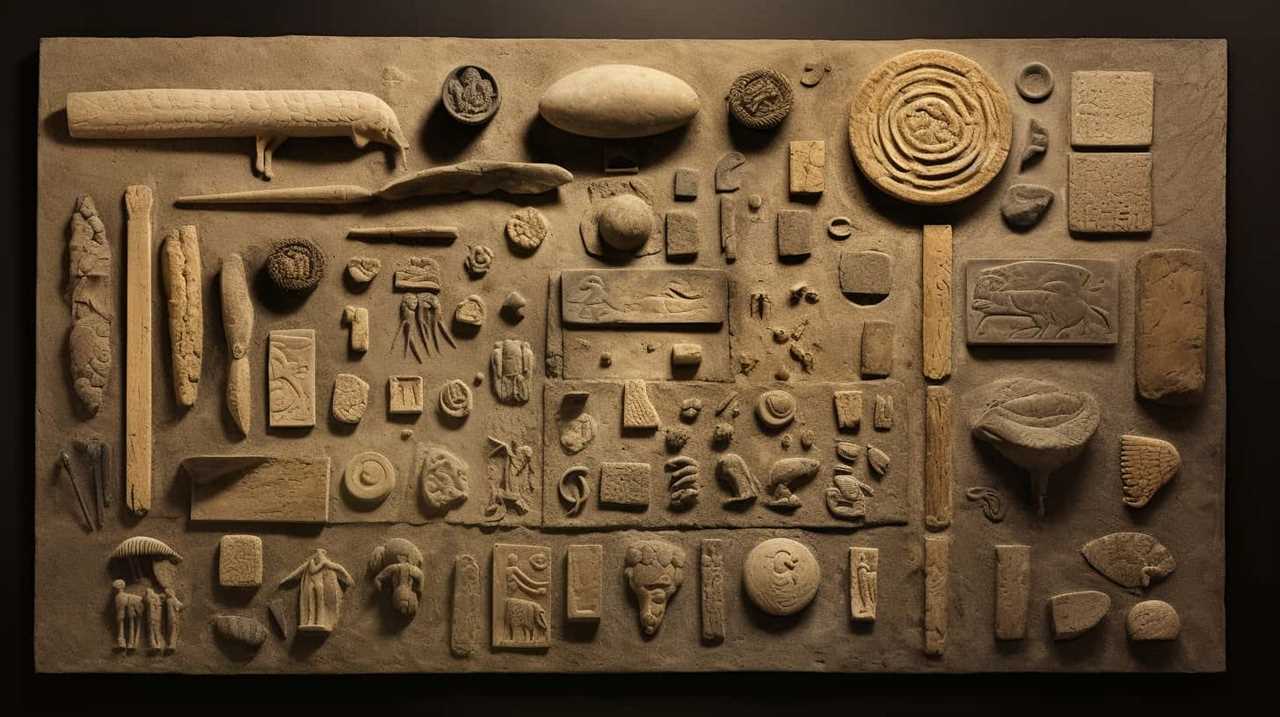
Through the decoding of cuneiform inscriptions, we’ve been able to uncover a wealth of knowledge about ancient Mesopotamian society, including their political systems, religious beliefs, and economic practices.
These inscriptions provide us with firsthand accounts of historical events, such as wars and conquests, as well as personal stories and legal documents.
The preservation techniques used in cuneiform, such as clay tablets and baked bricks, have allowed these ancient texts to survive for thousands of years, providing us with a window into the past and enriching our understanding of human history.
Insights From Ancient Cuneiform Texts
Through the analysis of ancient cuneiform texts, we gain valuable insights into the civilization and culture of Mesopotamia. These texts, written using ancient writing techniques, provide us with a window into the lives of the people who lived thousands of years ago. Deciphering ancient script has allowed us to uncover a wealth of information about their beliefs, social structures, and daily activities.

Here are some key insights we’ve gained from these texts:
- Religious practices: Cuneiform texts reveal the importance of religion in Mesopotamian society. They contain hymns, prayers, and rituals dedicated to various gods and goddesses, shedding light on their religious beliefs and practices.
- Legal systems: Cuneiform tablets also contain laws and legal codes that provide valuable information about the justice system in ancient Mesopotamia. They outline rules regarding property ownership, contracts, and penalties for crimes, giving us a glimpse into their legal framework.
- Economic activities: Cuneiform texts provide detailed records of economic activities such as trade, taxation, and agricultural practices. They offer insights into the organization of markets, the use of currency, and the management of resources in ancient Mesopotamia.
- Literary and artistic expressions: Cuneiform texts include epic poems, myths, and stories that showcase the literary and artistic talents of the Mesopotamian people. These texts allow us to appreciate their creativity and imagination, as well as the themes and motifs that were important to them.
Mesopotamian Wisdom Preserved in Stone
One can find a treasure trove of Mesopotamian wisdom preserved in stone through the study of cuneiform inscriptions. These ancient writings, etched onto tablets and monuments, provide valuable insights into the beliefs, values, and knowledge of the Mesopotamian civilization. The durability of stone has allowed these inscriptions to survive for thousands of years, offering us a glimpse into the past and shedding light on the intellectual and cultural achievements of this ancient society.
Mesopotamian wisdom, encompassing various aspects of life such as law, morality, and the nature of the divine, is beautifully encapsulated in these stone inscriptions. They reveal the Mesopotamians’ deep reverence for their gods and their belief in the interconnectedness of the natural and supernatural realms. These texts also provide practical advice on topics like farming, trade, and governance, showcasing the Mesopotamians’ practical knowledge and innovative thinking.
The preservation of Mesopotamian wisdom in stone is a testament to the importance placed on education and intellectual pursuits in this ancient civilization. The Mesopotamians recognized the value of recording their knowledge for future generations, ensuring that their wisdom would endure through the ages.
Transitioning into the subsequent section about ‘discovering Mesopotamia’s literary treasures,’ these stone inscriptions serve as a foundation for exploring the rich literary tradition of Mesopotamia. By studying these texts, we can unlock further insights into the intellectual, cultural, and literary achievements of this remarkable civilization.
Discovering Mesopotamia’s Literary Treasures
We are excited to explore Mesopotamia’s literary treasures, revealed through the study of cuneiform inscriptions. Mesopotamian literature holds immense historical and cultural significance, allowing us to gain profound insights into the lives and beliefs of ancient civilizations.
The importance of preserving these literary works can’t be overstated, as they provide a glimpse into the rich tapestry of Mesopotamian culture. They transport us back in time, enabling us to experience the thoughts, emotions, and experiences of people who lived thousands of years ago. They offer a unique perspective on the development of human civilization, shedding light on the intellectual and artistic achievements of the Mesopotamians.
They provide valuable information about the religious and mythological beliefs of these ancient societies, offering a window into their spiritual practices and worldview. They serve as a testament to the enduring power of storytelling, highlighting the universal human desire to communicate, entertain, and preserve knowledge.

The study of Mesopotamian literature not only enriches our understanding of the past but also helps us appreciate the timeless themes and ideas that continue to resonate with us today. By preserving and studying these literary treasures, we ensure that the voices of the ancient Mesopotamians aren’t forgotten, allowing their stories and wisdom to continue inspiring and enlightening future generations.
Enigmatic Messages From the Past
Continuing our exploration of Mesopotamia’s literary treasures, we delve into the enigmatic messages from the past revealed through the study of cuneiform inscriptions. These ancient writings, etched into clay tablets using a wedge-shaped stylus, offer a glimpse into the thoughts, beliefs, and daily life of the Mesopotamians. However, the symbols used in cuneiform script can be mysterious and challenging to decipher.
Deciphering techniques have been crucial in unraveling the secrets hidden within these inscriptions. Scholars have meticulously analyzed the patterns and variations in the symbols, comparing them with known texts and languages to identify commonalities and meanings. This process involves a deep understanding of the grammatical and linguistic structures of ancient Mesopotamian languages, such as Sumerian and Akkadian.
One such technique is the contextual approach, where researchers examine the surrounding text and the cultural context in which the inscription was created. By considering the purpose and audience of the writing, scholars can make educated guesses about the meaning of certain symbols or phrases.
Another technique involves comparing cuneiform inscriptions with other ancient texts, such as royal decrees, religious hymns, or legal documents. By identifying similarities in words and phrases, scholars can gradually build a lexicon of cuneiform symbols and their corresponding meanings.
Powerful Words of Mesopotamian Scribes
As we delve into the realm of Mesopotamian cuneiform inscriptions, we’re captivated by the power and eloquence exhibited in the words of these ancient scribes. The techniques employed by Mesopotamian scribes were truly remarkable, showcasing their mastery of the written word. Here are some examples of their literary wisdom that continue to resonate with us today:
- ‘The pen is mightier than the sword.’ This phrase, attributed to a Mesopotamian scribe, emphasizes the power of words to shape and influence society.
- ‘Knowledge is the key to unlocking the mysteries of the universe.’ Mesopotamian scribes recognized the importance of knowledge and the pursuit of wisdom in their writings.
- ‘Through writing, we immortalize our thoughts and experiences.’ Scribes understood the significance of preserving their ideas and experiences for future generations.
- ‘Words have the power to heal or harm.’ This statement highlights the responsibility of scribes in using their words wisely and ethically.
These insights into the world of Mesopotamian scribes provide a glimpse into the sophistication and intellectual depth of their society. Through their carefully crafted inscriptions, these ancient scribes left a lasting legacy of profound wisdom and literary excellence.
Frequently Asked Questions
How Were Cuneiform Inscriptions Used in Ancient Mesopotamia?
Cuneiform inscriptions were used for various purposes in ancient Mesopotamia. They served as a means of recording information, communicating ideas, and documenting legal, administrative, and religious matters. The significance of cuneiform writing cannot be overstated in understanding this ancient civilization.

What Tools Were Used to Create Cuneiform Inscriptions?
Tools and techniques used to create cuneiform inscriptions in ancient Mesopotamia included a stylus made of reed or bone, clay tablets, and a wedge-shaped writing system. These tools allowed for precise and durable writing.
How Were Cuneiform Inscriptions Deciphered and Translated?
Deciphering techniques for cuneiform inscriptions involved analyzing repeated signs, comparing them to known languages, and using bilingual texts. Translation methods included identifying word meanings, grammar rules, and context. It was a complex process requiring expertise and extensive knowledge.
Were Cuneiform Inscriptions Primarily Used for Practical or Decorative Purposes?
Cuneiform inscriptions were primarily used for practical purposes, such as record-keeping and communication. However, they also had cultural and historical significance, as they preserved important information about ancient Mesopotamian civilizations.
What Role Did Scribes Play in the Creation of Cuneiform Inscriptions?
Scribes played a crucial role in the creation of cuneiform inscriptions. Their expertise and knowledge were essential in preserving important information and recording historical events. The importance of cuneiform cannot be overstated as it provided a written record of Mesopotamian civilization.
Can you provide more Mesopotamian Cuneiform Inscription quotes similar to the ones you’ve already revealed?
Certainly! Here are some top Mesopotamian text quotes to further explore this ancient writing system: 1. “I am the queen, the gathering of the gods.” 2. “Oh, endless womb of the land, bearer of all things.” 3. “You are the storm, the roaring wind that brings life.
Conclusion
As we unravel the ancient cuneiform inscriptions of Mesopotamia, we’re transported to a world of wisdom and enigmatic messages. Through these powerful words, preserved in stone, we gain insights into the thoughts and beliefs of the past.
Each inscription is a literary treasure, holding secrets waiting to be decoded. Symbolizing the enduring power of knowledge, these inscriptions evoke a sense of awe and wonder, reminding us of the timeless connection between humanity and the written word.
Lauren’s talent in writing is matched by her passion for storytelling. Her love for books and deep understanding of culture and entertainment add a distinct flavor to her work. As our media and press contact, Lauren skillfully bridges the gap between afterQuotes and the broader media landscape, bringing our message to a wider audience.
Ancient Quotations
9 Powerful Stoicism Quotes to Conquer Challenges

Did you know that 90% of successful individuals adhere to the timeless principles of Stoicism? If you aim to conquer challenges and attain mastery in your life, then this is the perfect place for you to be.
In this article, we will explore 9 powerful Stoicism quotes that will equip you with the tools to overcome any obstacle that comes your way. Stoicism, with its focus on resilience, acceptance, wisdom, inner strength, discipline, embracing change, courage, finding peace, and cultivating virtuous qualities, provides a practical and actionable framework for personal growth and excellence.
By internalizing these Stoic principles, you can navigate life’s challenges with grace and emerge stronger, wiser, and more resilient than ever before. So, let’s dive into these empowering Stoicism quotes and unlock the secrets to conquering challenges.
Key Takeaways
- Stoicism encourages us to remain steadfast in the face of challenges and see obstacles as opportunities for growth.
- Stoicism emphasizes the importance of focusing on what we can control, such as our perception and response to challenges.
- Cultivating gratitude and practicing self-control are essential stoic virtues that foster resilience and inner calm.
- Stoicism teaches us to embrace change, recognize its inevitability, and adapt to it for personal growth and well-being.
Stoicism Quotes on Resilience
We frequently find solace and strength within stoicism’s teachings as they remind us of our own resilience in the face of adversity. Stoicism provides a practical philosophy that encourages us to remain steadfast and unwavering in the midst of life’s challenges. Stoic quotes on perseverance serve as powerful reminders of our ability to overcome obstacles and emerge stronger on the other side.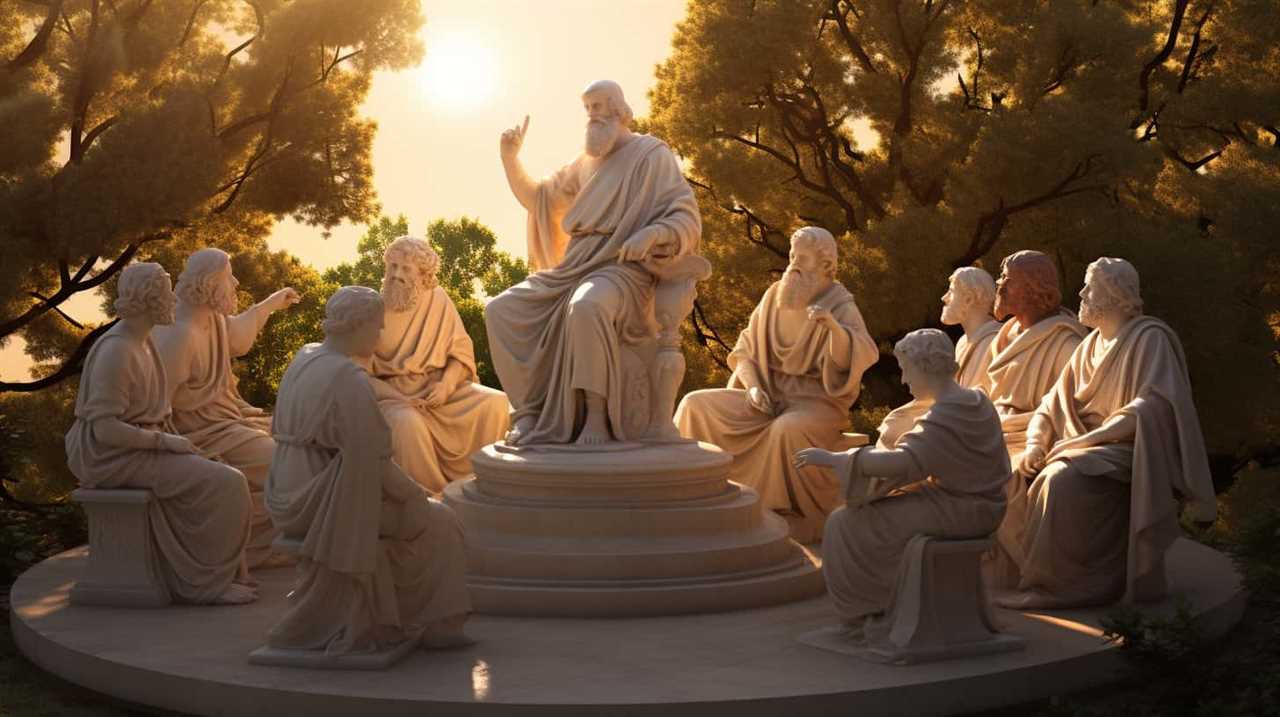
One such quote comes from Marcus Aurelius, who said, ‘The impediment to action advances action. What stands in the way becomes the way.’ This quote encapsulates the stoic belief that obstacles aren’t roadblocks, but rather opportunities for growth and progress. It reminds us that our response to adversity is within our control and that we’ve the power to transform obstacles into stepping stones towards success.
Another stoic quote on overcoming adversity comes from Epictetus, who stated, ‘It’s not what happens to you, but how you react to it that matters.’ This quote emphasizes the importance of maintaining a resilient mindset in the face of challenges. It reminds us that our perspective and attitude towards adversity can greatly influence our ability to overcome it.
As we delve into the topic of stoic quotes on acceptance, it’s important to recognize that resilience and acceptance often go hand in hand. Stoicism teaches us to accept the things we can’t change and to focus our energy on what we can control. Through this acceptance, we find the strength to persevere and overcome the adversities that life throws our way.
Stoic Quotes on Acceptance
As we explore stoic quotes on acceptance, it’s essential to understand the profound wisdom that Stoicism offers in embracing and embracing the things we can’t change. Stoicism teaches us the importance of surrendering to the realities of life and letting go of our attachments to outcomes.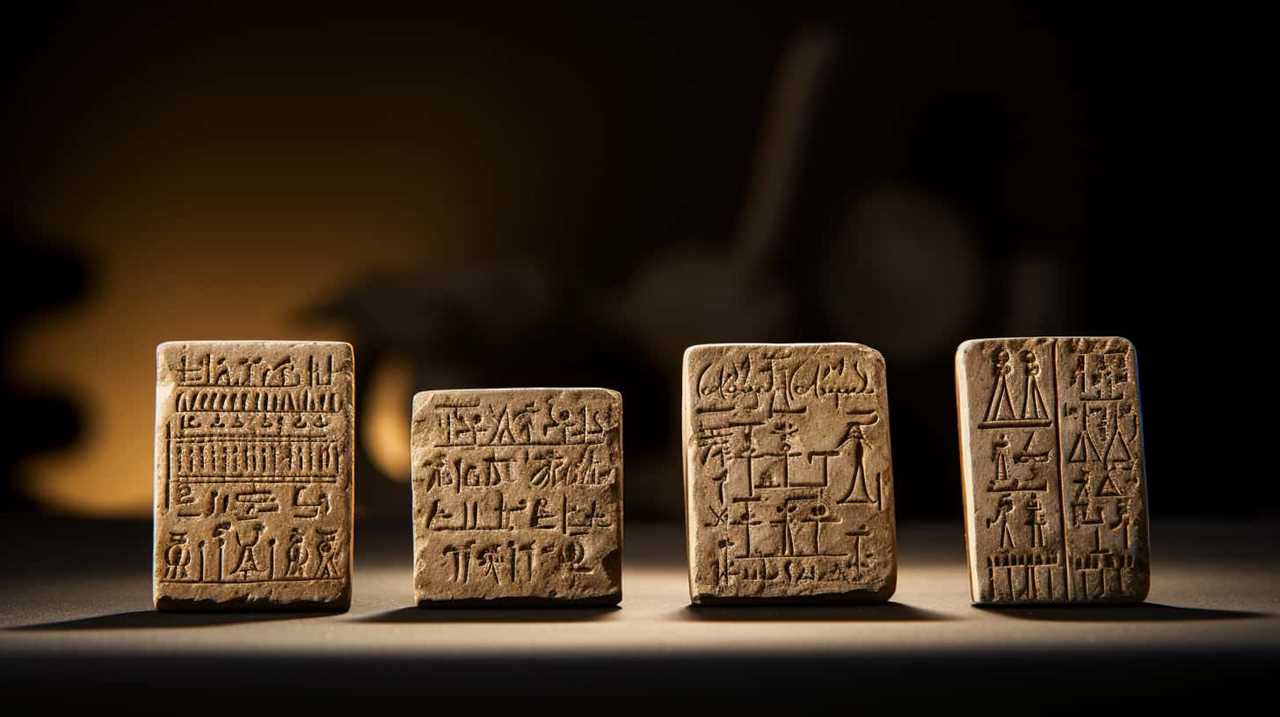
One powerful stoic quote on surrender comes from Epictetus, who said, ‘Do not seek to have events happen as you want them to, but instead want them to happen as they do happen, and your life will go well.’ This quote reminds us that we’ve no control over external events, and it’s futile to resist or try to change them. Instead, we should accept them as they’re and focus on our own inner state.
Another stoic quote on letting go comes from Marcus Aurelius, who said, ‘Accept the things to which fate binds you and love the people with whom fate brings you together, but do so with all your heart.’ This quote emphasizes the importance of accepting our circumstances and the people in our lives. It encourages us to embrace them fully, without resistance or judgment.
By accepting what we can’t change and letting go of our attachments, we free ourselves from unnecessary suffering and find peace within.
Quotes on Stoic Wisdom
When it comes to facing challenges, Stoic wisdom offers valuable insights that can help us develop resilience and navigate through difficult times.
Stoicism emphasizes the importance of internal strength and the ability to control our own thoughts and reactions.
Stoic Quotes for Resilience
Conquering challenges requires embodying stoic wisdom, which can be achieved by embracing resilience through powerful stoic quotes.
Stoicism quotes on inner strength serve as a guiding light, reminding us to stay strong and resilient in the face of adversity. One such quote by Marcus Aurelius states, ‘You have power over your mind – not outside events. Realize this, and you’ll find strength.’ This quote emphasizes the importance of focusing on what we can control, our own thoughts and actions, rather than being consumed by external circumstances.
Another stoic quote by Epictetus encourages us to develop resilience by accepting and adapting to the challenges we face: ‘It’s not what happens to you, but how you react to it that matters.’ This quote reminds us that our perception and response to challenges are within our control.
Applying Stoic Wisdom
To apply stoic wisdom in our lives, we can draw inspiration from powerful stoicism quotes that offer valuable insights and guidance. Stoic teachings, when applied in daily life, can help us navigate challenges with resilience and inner strength. By embracing stoic principles, we can cultivate a mindset that allows us to focus on what is within our control, rather than getting caught up in external circumstances. This shift in perspective empowers us to approach life’s difficulties with equanimity and acceptance. Stoicism teaches us to detach ourselves from outcomes and to instead focus on our own actions and attitudes. Through practicing gratitude, mindfulness, and self-reflection, we can develop a stoic mindset that enables us to face challenges head-on and find peace amidst chaos.
| Stoic Wisdom Quotes | Explanation |
|---|---|
| "The only thing you control is your own mind." | This quote reminds us that we have the power to control our thoughts and reactions, regardless of external circumstances. |
| "What upsets people is not things themselves, but their judgments about these things." | By recognizing that our judgments and interpretations shape our emotional responses, we can choose to adopt more rational and balanced perspectives. |
| "The obstacle is the way." | This quote emphasizes the stoic belief that obstacles and challenges are not to be avoided, but rather embraced as opportunities for growth and self-improvement. |
| "Amor fati." | This Latin phrase, meaning "love of fate," encourages us to embrace all aspects of our lives, both positive and negative, as essential parts of our journey. |
Stoicism Quotes on Inner Strength
As we explore Stoicism Quotes on Inner Strength, it becomes clear that the philosophy emphasizes the cultivation of resilience and resilience in the face of adversity. Stoic teachings provide valuable insights into developing our inner strength and overcoming challenges.
Here are three powerful stoicism quotes on self-control and overcoming adversity:
- ‘You have power over your mind – not outside events. Realize this, and you’ll find strength.’ – Marcus Aurelius
This quote reminds us that our strength lies within our ability to control our thoughts and reactions, rather than trying to control external circumstances. By focusing on our own attitudes and actions, we can cultivate inner resilience and face any adversity with grace.
- ‘The greater the difficulty, the more glory in surmounting it.’ – Epictetus
Epictetus teaches us that challenges are opportunities for growth and self-improvement. Instead of avoiding difficulties, we should embrace them as chances to showcase our inner strength and achieve greatness.
- ‘The obstacle is the way.’ – Ryan Holiday
This quote highlights the Stoic belief that obstacles aren’t setbacks but rather the path to success. By reframing obstacles as opportunities, we can tap into our inner strength and find creative solutions to overcome any adversity we encounter.
Stoic philosophy encourages us to develop our inner strength by practicing self-control and embracing challenges. By cultivating resilience and facing adversity head-on, we can conquer any obstacles that come our way and achieve true mastery in life.
Quotes on Stoic Discipline
With a focus on cultivating inner strength and resilience, stoic philosophy emphasizes the importance of discipline in navigating life’s challenges. Stoic discipline techniques provide a framework for developing self-control, mental fortitude, and emotional stability. These techniques, when applied in daily life, enable individuals to overcome obstacles and lead a virtuous and fulfilling existence.
To delve deeper into the concept of stoic discipline, let’s examine a table that highlights some key quotes from stoic philosophers on this topic:
| Stoic Discipline Quotes | Philosopher | Meaning |
|---|---|---|
| "The chief task in life" | Epictetus | The primary goal in life is to discipline our desires. |
| "Discipline your mind" | Marcus Aurelius | Train your mind to focus on what you can control. |
| "Self-control is strength" | Seneca | True strength lies in mastering oneself. |
| "Learn to be indifferent" | Epictetus | Embrace indifference towards external events. |
| "Endure and renounce" | Marcus Aurelius | Bear hardships and let go of attachments. |
These quotes underscore the importance of discipline in stoic philosophy. By practicing self-control, focusing on what is within our control, embracing indifference towards external outcomes, and letting go of attachments, we can navigate life’s challenges with resilience and inner strength.
Incorporating stoic discipline in daily life requires consistent effort and conscious decision-making. It involves recognizing our own desires, emotions, and reactions, and actively working towards aligning them with reason and virtue. By adopting stoic discipline techniques, we can cultivate a sense of inner harmony, withstand adversity, and live a life guided by wisdom and tranquility.
Stoic Quotes on Embracing Change
Embracing change can be challenging, but it’s important to recognize the hidden benefits that come with it.
Stoicism offers a valuable guide to adaptability, reminding us that change is inevitable and it’s how we respond to it that truly matters.
Embracing Change’s Hidden Benefits
Change brings about numerous hidden benefits that we, as individuals, often fail to recognize. Embracing change can be intimidating, as it requires us to step out of our comfort zones and face the unknown. However, when we overcome our fear of change, we unlock a world of possibilities and growth.
Here are three hidden benefits of embracing change:
- Personal growth: Change forces us to adapt and learn new skills, which leads to personal growth and development. It challenges us to step outside of our familiar routines and expand our horizons.
- Resilience: Embracing change teaches us resilience and the ability to bounce back from setbacks. It strengthens our mental and emotional muscles, preparing us to face future challenges with a positive mindset.
- Opportunities for success: Change often brings new opportunities that we may not have encountered otherwise. Embracing change opens doors to new experiences, relationships, and achievements that can lead to greater success in our personal and professional lives.
Stoicism’s Guide to Adaptability
When we embrace change, we gain valuable insights and practical wisdom from the teachings of Stoicism on adaptability, as exemplified by the following powerful stoic quotes.
The stoic mindset encourages us to recognize that change is inevitable and that our ability to adapt to it’s crucial for our growth and well-being. Stoicism teaches us that instead of resisting change or being overwhelmed by it, we should embrace it as an opportunity for growth and self-improvement.
By cultivating an adaptable mindset, we can navigate through life’s challenges with resilience and grace. Stoicism provides us with valuable tools and techniques for overcoming adversity and finding strength in the face of change. It reminds us that our true power lies in how we choose to respond to the ever-changing circumstances of life.
As we explore these stoic quotes on adaptability, we’ll gain a deeper understanding of how to embrace change and thrive in any situation.
Now, let’s transition into the next section where we’ll delve into stoic quotes on courage.
Quotes on Stoic Courage
As we delve into the realm of Stoic Courage, it becomes evident that embracing challenges with resilience and fortitude is essential for personal growth and triumph. Stoicism teaches us to face adversity head-on and to cultivate the inner strength needed to overcome any obstacle that comes our way.
Here are three powerful quotes on stoic courage that can inspire us to confront our challenges with unwavering determination:
- ‘The greater the difficulty, the more glory in surmounting it.’ – Epictetus This quote reminds us that the true measure of our courage lies in our ability to conquer difficult situations. By embracing challenges, we not only demonstrate our resilience but also create opportunities for personal growth and self-improvement.
- ‘Courage isn’t the absence of fear, but the triumph over it.’ – Seneca Seneca reminds us that courage isn’t the absence of fear, but rather the ability to face our fears and conquer them. It’s through confronting our fears that we develop the strength and courage necessary to overcome challenges.
- ‘Do not pray for an easy life; pray for the strength to endure a difficult one.’ – Bruce Lee This quote emphasizes the importance of developing inner strength and resilience. Instead of seeking an easy life, we should focus on building the fortitude to withstand difficult times. By doing so, we can face challenges head-on and emerge stronger on the other side.
As we explore stoic courage and its role in overcoming challenges, it becomes evident that finding peace within ourselves is an integral part of the journey.
Stoicism Quotes on Finding Peace
To attain inner tranquility, we must embrace stoicism’s wisdom on finding peace and incorporate its teachings into our lives. Stoicism offers invaluable insights into achieving tranquility and finding inner calm amidst the chaos of life. Let us explore some powerful stoicism quotes on finding peace:
| Quotes on Finding Peace |
|---|
| "The happiness of your life depends upon the quality of your thoughts." – Marcus Aurelius |
| "Peace is not the absence of conflict, but the ability to cope with it." – Epictetus |
| "The greatest obstacle to living is expectancy, which hangs upon tomorrow and loses today. You are arranging what lies in Fortune’s control, and abandoning what lies in yours." – Seneca |
| "If you are disturbed by external events, it is not the events themselves that trouble you, but only your own judgment about them. And it is in your power to wipe out that judgment now." – Marcus Aurelius |
These quotes remind us that finding peace requires a shift in mindset and the ability to control our thoughts and judgments. Stoicism teaches us that true tranquility comes from within, and that external events should not dictate our inner state. By practicing mindfulness and focusing on the present moment, we can cultivate a sense of calm and find peace even in the face of adversity. Stoicism’s wisdom on finding peace serves as a powerful guide for those seeking mastery over their own emotions and inner turmoil.
Quotes on Stoic Virtues
In our journey to conquer challenges, let’s delve into the wisdom of stoic virtues. Stoicism teaches us to cultivate certain qualities that can help us navigate life’s difficulties with resilience and inner strength. Here are some powerful stoic quotes on gratitude and self-control:
- ‘Gratitude isn’t only the greatest of virtues but the parent of all others.’ – Marcus Tullius Cicero
Gratitude is a foundational virtue that enables us to appreciate the present moment and find joy in the simple things. By cultivating gratitude, we can shift our focus from what we lack to what we already have, fostering contentment and resilience.
- ‘No man is free who isn’t master of himself.’ – Epictetus
Self-control is a crucial virtue that allows us to govern our desires, emotions, and actions. By practicing self-control, we can resist impulsive behavior, make rational decisions, and maintain inner calm in the face of challenges.
- ‘He is a wise man who doesn’t grieve for the things which he’s not, but rejoices for those which he has.’ – Epictetus
This quote reminds us of the importance of focusing on what we’ve rather than dwelling on what we lack. By cultivating a mindset of abundance and gratitude, we can find joy and contentment in our present circumstances, regardless of external circumstances.
Incorporating these stoic virtues of gratitude and self-control into our lives can help us navigate challenges with grace and mastery.
Frequently Asked Questions
What Are Some Practical Steps to Cultivate Resilience in Daily Life?
To cultivate resilience in daily life and overcome challenges, we must actively seek out opportunities for personal growth, maintain a positive mindset, and embrace adversity as a chance to learn and become stronger.
How Can Stoic Principles Help Individuals in Accepting Difficult Circumstances?
Stoic principles offer valuable insights for accepting difficult circumstances and overcoming adversity. By embracing the philosophy’s teachings, we can cultivate resilience, find inner strength, and maintain a sense of tranquility amidst life’s challenges.

Are There Any Specific Stoic Teachings That Focus on the Pursuit of Wisdom?
In the pursuit of wisdom, Stoic teachings provide invaluable guidance. By emphasizing self-reflection, rationality, and the cultivation of virtue, Stoicism equips individuals with the tools necessary to navigate life’s challenges and uncover profound truths.
How Can Stoic Philosophy Help Individuals in Developing Inner Strength?
Developing resilience and building mental fortitude are key aspects of stoic philosophy. By teaching us to accept what is beyond our control and focus on what we can change, stoicism empowers us to face challenges with inner strength.
What Are Some Effective Strategies to Practice Stoic Discipline in Modern Society?
In modern society, we can employ various strategies to practice stoic discipline and conquer challenges. By focusing on our inner thoughts, accepting what is beyond our control, and maintaining a sense of gratitude, we can cultivate resilience and inner strength.
How Are the Stoicism Quotes Related to the Strategies for Overcoming Challenges?
Stoicism quotes emphasize the importance of embracing challenges and finding inner strength to overcome them. The stoic strategies for challenges encourage resilience, self-discipline, and the ability to adapt to adversity. By focusing on what is within our control and accepting the things we cannot change, Stoicism offers valuable insights into facing life’s obstacles with courage and grace.
Conclusion
In conclusion, these powerful stoicism quotes provide valuable insights and guidance for conquering challenges in life. By embracing resilience, acceptance, wisdom, inner strength, discipline, embracing change, courage, finding peace, and cultivating virtues, we can navigate through difficult times with grace and determination.
Like a sturdy ship navigating stormy seas, stoicism teaches us to stay steady amidst the waves, always finding our way to calmer waters.
Lauren’s talent in writing is matched by her passion for storytelling. Her love for books and deep understanding of culture and entertainment add a distinct flavor to her work. As our media and press contact, Lauren skillfully bridges the gap between afterQuotes and the broader media landscape, bringing our message to a wider audience.
Ancient Quotations
9 Best Egyptian Hieroglyphic Sayings Deciphered
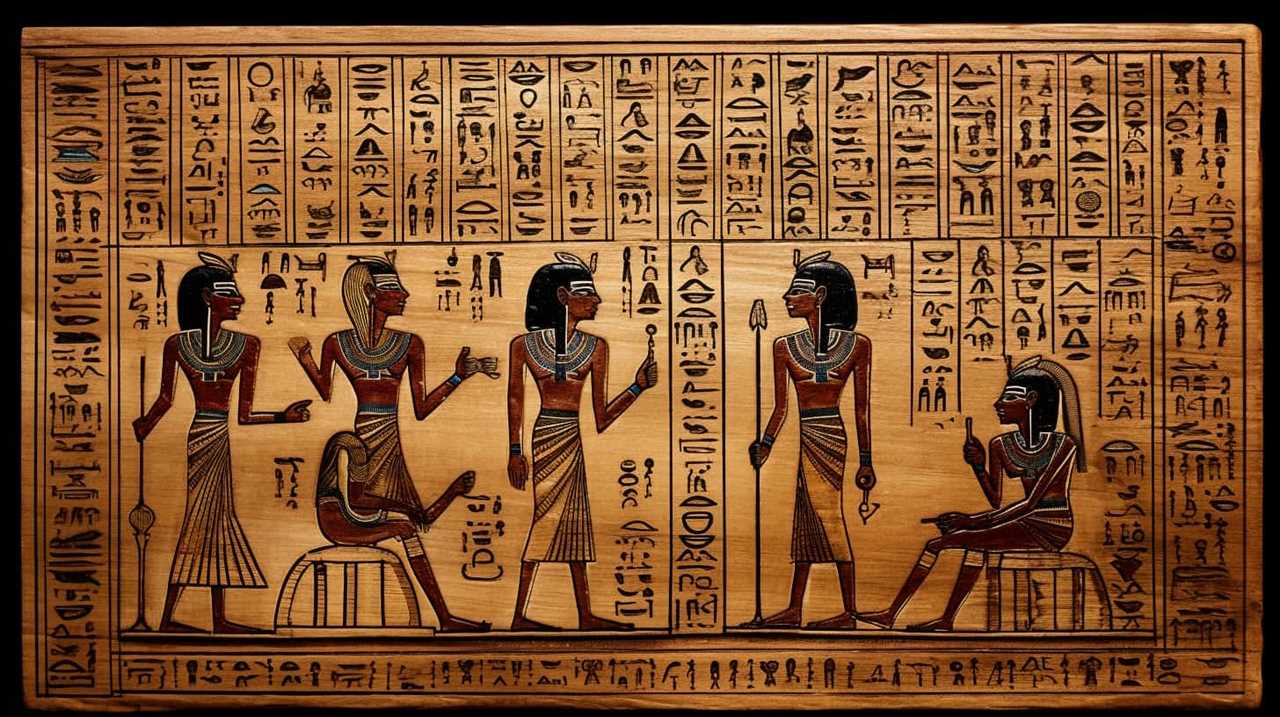
While delving into the secrets of ancient Egypt, we have unearthed valuable insights hidden within the intricate hieroglyphics. These enigmatic symbols, etched onto the walls of temples and tombs, play a crucial role in understanding the beliefs and culture of a civilization that thrived thousands of years ago.
Join us as we delve into the enchanting world of Egyptian hieroglyphic sayings, deciphering their meanings and unraveling their mysteries. From the timeless wisdom of Ma’at to the eternal flame of Ra, we will explore the profound insights that shaped the lives of the pharaohs and their subjects.
Prepare to embark on a voyage of mastery, as we bring to light the nine best Egyptian hieroglyphic sayings ever deciphered.
Key Takeaways
- Egyptian hieroglyphic sayings provide profound insights into ancient Egyptian beliefs and values.
- Decoding hieroglyphic messages reveals ancient wisdom and offers a deeper understanding of ancient Egyptian society.
- Hieroglyphic sayings emphasize the importance of maintaining a harmonious relationship with the Divine Pharaoh for prosperity and protection.
- Understanding hieroglyphs is crucial for unraveling the mysteries of ancient Egyptian civilization and gaining insights into their culture and history.
The Power of Ma’at
One of the most powerful and enduring concepts in ancient Egyptian civilization is the belief in the power of Ma’at. Ma’at represents the fundamental principle of balance and harmony that governs the universe. The ancient Egyptians believed that maintaining the power of balance, or Ma’at, was essential for the well-being and prosperity of society.
The concept of Ma’at was deeply ingrained in every aspect of Egyptian life, from religious rituals to the administration of justice. It was believed that when Ma’at was upheld, order and stability prevailed. The pharaoh, as the earthly embodiment of Ma’at, was responsible for upholding this balance and ensuring that justice was served.
The power of Ma’at also encompassed the notion of ancient wisdom. The Egyptians believed that the principles of Ma’at were derived from the wisdom of their gods and ancestors. This ancient wisdom guided their understanding of the natural world and their place within it.
The belief in the power of Ma’at continues to resonate throughout history, inspiring countless generations to strive for balance and harmony in their lives. It serves as a reminder of the importance of maintaining equilibrium in a world that’s constantly changing. The power of Ma’at remains an enduring legacy of ancient Egyptian civilization.
Life’s Journey in the Nile
How can we navigate Life’s Journey in the Nile?
The Nile River, with its powerful currents and treacherous waters, serves as a metaphor for the challenges we face in life. Just as the ancient Egyptians relied on the Nile for sustenance and prosperity, we too must navigate the obstacles that come our way and find our inner strength to overcome them.
To evoke emotion in our audience, let’s consider two sub-lists:
Navigating Obstacles:
- The Nile, with its unpredictable floods and dangerous wildlife, symbolizes the hurdles we encounter in life. We must learn to adapt and find alternative paths when faced with unexpected challenges.
- Like the ancient Egyptians who built canals and irrigation systems to control the Nile’s flow, we must develop strategies and tools to overcome obstacles and steer our lives in the desired direction.
Finding Inner Strength:
- The Nile’s journey from the heart of Africa to the Mediterranean Sea is an arduous one. Similarly, our life’s journey requires resilience and perseverance. We must tap into our inner strength to keep moving forward, even in the face of adversity.
- Just as the Nile’s waters provide sustenance to the fertile lands it touches, we must nourish our minds and souls to find the strength to overcome challenges. Cultivating self-care practices and seeking support from loved ones can help us navigate life’s journey with grace and resilience.
Wisdom of the Sphinx
As we explore the subtopic of ‘Wisdom of the Sphinx’, we encounter a trove of hidden riddles and ancient symbols that have fascinated scholars and historians for centuries.
The Sphinx, with its enigmatic gaze and mysterious presence, holds a wealth of wisdom that transcends time.
Sphinx’s Hidden Riddles
After deciphering the best Egyptian hieroglyphic sayings, we discovered the profound wisdom of the Sphinx’s hidden riddles.
The Sphinx, with its enigmatic expression and majestic presence, has captivated the human imagination for centuries. Its riddles, carefully crafted and tucked away in the sands of time, hold the key to unlocking ancient secrets.
These riddles aren’t mere puzzles to be solved, but rather profound teachings that offer insight into the human condition and the mysteries of existence. They challenge our intellect and provoke introspection, pushing us to delve deeper into the realms of knowledge and wisdom.
The Sphinx’s riddles, when deciphered, reveal truths that are timeless and universal, reminding us of the power of ancient wisdom in guiding our modern lives.
Now, let’s explore the ancient symbols and their modern meaning.
Ancient Symbols, Modern Meaning
We have uncovered the modern meaning behind the ancient symbols of the Sphinx, revealing a wealth of wisdom.
Egyptian hieroglyphic symbols have intrigued scholars and enthusiasts for centuries, serving as a window into the ancient Egyptian civilization. Decoding these symbols allows us to gain insight into the beliefs, values, and knowledge of the ancient Egyptians. The hieroglyphs often depict aspects of daily life, religious rituals, and divine beings.
Through careful analysis and comparison, we’ve been able to decipher the hidden messages encoded in these symbols, unveiling their true significance. These ancient symbols, once enigmatic, now offer profound insights into the mindset and worldview of the Egyptian people.
Decoding Wisdom Through History
Continuing our exploration of ancient Egyptian hieroglyphic symbols, let’s delve into the profound wisdom revealed by the enigmatic Sphinx. Decoding ancient wisdom through the historical symbolism of this majestic creature allows us to tap into the collective knowledge of our ancestors.
Here are two sub-lists that evoke emotion in our audience:
- Eternal Guardians of Mysteries:
- The Sphinx stands as a testament to the timeless pursuit of knowledge.
- Its inscrutable gaze beckons us to uncover the secrets of the past.
- Unveiling the Truth Within:
- Through deciphering hieroglyphic messages, we gain access to the ancient wisdom embedded in the Sphinx’s engravings.
- The historical symbolism of this iconic figure reveals profound insights about life, death, and the human condition.
The Magic of the Ankh
Rarely do we encounter an ancient Egyptian symbol as powerful and enigmatic as the Ankh. The Ankh, also known as the Key of Life, is a symbol that holds deep significance in Egyptian culture. It is believed to represent eternal life and immortality, making it one of the most revered symbols in ancient Egypt.
The symbolism of the Ankh is multi-faceted and rich in meaning. Its looped top represents the eternal cycle of life, while the vertical line represents the path of the soul. Together, they symbolize the union of opposites, the balance between life and death, and the eternal nature of the soul.
In Egyptian mythology, the Ankh was often associated with gods and goddesses, who were believed to hold the power of life and death. It was also believed to be a talisman that could bring protection, good fortune, and fertility to its wearer.
To better understand the symbolism of the Ankh, let us explore its various meanings and interpretations in the table below:

| Symbolism | Meaning |
|---|---|
| Eternal Life | Represents the concept of life beyond death |
| Balance | Symbolizes the harmony between opposites |
| Fertility | Associated with the power of creation and reproduction |
As we delve deeper into the mysteries of ancient Egypt, the Ankh continues to captivate us with its magic and profound symbolism. It serves as a reminder of the enduring legacy and wisdom of this ancient civilization.
Embracing the Eye of Horus
When exploring the captivating world of Egyptian hieroglyphic sayings, one can’t overlook the significance of embracing the Eye of Horus. This ancient symbol holds deep symbolic meaning, representing protection, healing, and intuition.
Horus, the falcon-headed god, is revered as a powerful and watchful deity, making the Eye of Horus a potent talisman to embrace and invoke.
Understanding the cultural significance of this symbol allows us to delve into the rich tapestry of Egyptian beliefs and traditions.
Symbolic Meaning of Eye
We are fascinated by the Symbolic Meaning of the Eye, as it encompasses the embrace of the Eye of Horus. The ancient Egyptians attributed great symbolic significance to the eye, believing it to be a powerful symbol of protection, healing, and knowledge. The mythological origins of this symbolism can be traced back to the Eye of Horus, a symbol of the god’s all-seeing power and divine protection.
The Eye of Horus represents clarity and vision, serving as a reminder to seek wisdom and enlightenment. It symbolizes the concept of ‘utchat,’ or the eye of Ra, which was believed to bring protection against evil forces and ward off negative energy.
Understanding the symbolic meaning of the eye allows us to delve deeper into the rich cultural and spiritual traditions of ancient Egypt, unlocking valuable insights into their worldview and beliefs.
Horus as Protective Deity
As believers in the power of ancient Egyptian hieroglyphic sayings, we embrace the protective deity Horus and his association with the Eye of Horus. Horus, often depicted as a falcon-headed god, was one of the most significant deities in the ancient Egyptian pantheon. He was considered the protector and ruler of Egypt, embodying the divine kingship.
Horus’ association with the Eye of Horus adds to his protective role. The Eye of Horus symbolizes royal power, health, and prosperity. Amulets in the shape of the Eye of Horus were worn by both the living and the deceased as a means of protection. These amulets were believed to ward off evil and ensure the wearer’s well-being.
The symbolism of the falcon and the significance of amulets connected to the Eye of Horus demonstrate the enduring belief in Horus as a powerful guardian and protector.
Cultural Significance of Eye
Continuing our exploration of the cultural significance of the Eye of Horus, we delve into its embrace as believers in the power of ancient Egyptian hieroglyphic sayings. The Eye of Horus holds deep cultural symbolism and carries a profound historical interpretation.
The Eye of Horus embodies protection and healing, offering a sense of security and warding off evil forces. It symbolizes the watchful and compassionate eye of a god, providing guidance and wisdom to those who seek it.
The Eye of Horus also represents the concept of resurrection and eternal life. It signifies the cyclical nature of existence, reminding us that life and death are intertwined, and that death is merely a transition to a different state of being.
Understanding the cultural symbolism and historical interpretation of the Eye of Horus allows us to appreciate its significance as a powerful symbol in ancient Egypt. It serves as a reminder of the profound beliefs and values held by the ancient Egyptians, and continues to inspire and captivate us today.
The Balance of Isfet and Ma’at
Exploring the delicate equilibrium between Isfet and Ma’at, we delve into the ancient Egyptian belief system. The importance of balance was a central concept in their worldview, as they sought to maintain harmony in all aspects of life. Isfet, representing chaos, disorder, and injustice, was seen as the antithesis of Ma’at, which symbolized order, balance, and justice.
To understand Isfet and Ma’at, one must grasp the fundamental principles that guided ancient Egyptians. Isfet was associated with actions and behaviors that disrupted the natural order of the universe. It represented negative qualities such as violence, dishonesty, and greed. Ma’at, on the other hand, encompassed positive attributes like truth, harmony, and righteousness. It was believed that upholding Ma’at ensured the smooth functioning of the world and the well-being of individuals.
Maintaining the balance between Isfet and Ma’at was vital for the Egyptians. They believed that if Isfet gained dominance, chaos would prevail, leading to disasters and calamities. Therefore, individuals were expected to live their lives in accordance with Ma’at, striving to uphold its principles in their thoughts, words, and actions.
Rebirth Through the Scarab Beetle
The Scarab Beetle symbolizes rebirth in ancient Egyptian hieroglyphic sayings. The ancient Egyptians believed that the scarab beetle, also known as the dung beetle, represented the cycle of life and death. This symbolism can be seen in various aspects of their culture and religious beliefs.
The scarab beetle’s behavior of rolling dung into a ball and burying it in the ground was seen as a representation of the sun’s daily journey across the sky. Just as the sun would disappear at night and rise again in the morning, the scarab beetle would emerge from the ground, symbolizing rebirth and renewal.
The scarab beetle also played a significant role in the afterlife beliefs of the ancient Egyptians. They believed that the beetle was associated with the god Khepri, who was responsible for the creation and renewal of life. The scarab amulets, often placed on the mummified bodies of the deceased, were believed to provide protection and ensure a successful journey into the afterlife.

In addition to its symbolism of rebirth, the scarab beetle also represented fertility and regeneration. The Egyptians believed that the beetle possessed the power to bring about new life and restore what was lost. This belief in the scarab beetle’s ability to bring about renewal and transformation is a testament to the profound impact it had on ancient Egyptian beliefs.
Respecting the Divine Pharaoh
As we delve further into ancient Egyptian hieroglyphic sayings, it is evident that our reverence for the Divine Pharaoh is paramount. The Egyptians believed that the Pharaoh was not just a mortal ruler, but a divine being with a direct connection to the gods. This belief was deeply ingrained in their society and shaped their rituals and customs.
To demonstrate the importance of respecting the Divine Pharaoh, let us examine some hieroglyphic sayings that highlight this reverence:
| Hieroglyphic Saying | English Translation |
|---|---|
| 👑👁️👑 | The Pharaoh is the all-seeing eye of the gods. |
| ⚡🌞⚡ | The Pharaoh is the powerful sun, radiating divine energy. |
| 🌺👑🌺 | The Pharaoh is the beautiful flower, blooming with divine grace. |
| 🌍👑🌍 | The Pharaoh is the earth itself, guiding and protecting his people. |
| ⚖️👑⚖️ | The Pharaoh is the just balance, ensuring harmony and order in the kingdom. |
These sayings reveal the Egyptians’ deep respect for their divine ruler. They saw the Pharaoh as the embodiment of the gods on Earth, responsible for maintaining the balance between the mortal and divine realms. Through ancient rituals and ceremonies, they sought to honor and appease the Pharaoh, believing that his favor would bring prosperity and protection to the kingdom.
Understanding the significance of these hieroglyphic sayings allows us to gain insight into the ancient Egyptians’ mindset and worldview. It highlights the central role played by the Divine Pharaoh in their society and underscores the importance they placed on maintaining a harmonious relationship with their ruler.
The Eternal Flame of Ra
Continuing our exploration of ancient Egyptian hieroglyphic sayings, let’s delve into the captivating realm of ‘The Eternal Flame of Ra’. In ancient religious practices, the solar deity Ra held a significant place of reverence and worship. The Eternal Flame of Ra symbolized the eternal power and presence of this mighty deity.
Here are two sub-lists that will surely evoke emotions in our audience:
- The Divine Light:
- The Eternal Flame of Ra represents the divine light that illuminates the world, bringing warmth, life, and energy to all living beings.
- This sacred flame is believed to be the embodiment of Ra’s eternal power, radiating brilliance and providing spiritual guidance to the ancient Egyptians.
- The Cycle of Life:
- The Eternal Flame of Ra also symbolizes the cyclical nature of life, mirroring the rising and setting of the sun each day.
- Just as the sun rises and sets, the flame of Ra represents the eternal cycle of creation, death, and rebirth, reminding us of the impermanence of all things.
Understanding the significance of the Eternal Flame of Ra allows us to gain deeper insight into the ancient religious practices of the Egyptians. It reminds us of their profound connection to the sun and their belief in the eternal power and presence of the solar deity.
Frequently Asked Questions
How Were Hieroglyphics Deciphered and What Methods Were Used?
To decipher hieroglyphics, we utilized various methods such as the Rosetta Stone and the work of key figures like Jean-François Champollion. By comparing known languages, we identified phonetic and symbolic elements, unlocking the secrets of ancient Egypt’s written language.
Are There Any Hieroglyphic Sayings That Are Still Considered Undeciphered or Mysterious?
Undeciphered hieroglyphic sayings and mysterious hieroglyphic phrases continue to captivate scholars. Despite our best efforts, these enigmatic messages remain elusive, shrouded in the ancient secrets of the Egyptian civilization.
Can You Provide Examples of Hieroglyphic Sayings That Have Been Widely Used in Ancient Egyptian Culture?
Examples of widely used hieroglyphic sayings in ancient Egyptian culture include phrases like "life, prosperity, and health" and "eternal life." These sayings were deciphered using methods such as the Rosetta Stone and the work of Champollion.
What Role Did Hieroglyphic Sayings Play in Ancient Egyptian Religious Practices?
Hieroglyphic sayings played a pivotal role in ancient Egyptian religious practices. They were not only a form of artistic expression, but also held deep significance in the literature of the time.
Are There Any Hieroglyphic Sayings That Have Been Found to Have Multiple Interpretations or Meanings?
Multiple interpretations and meanings are common in hieroglyphic sayings. The complexity and symbolism of the ancient Egyptian language allow for various understandings, adding depth to the study of hieroglyphics.
Are the Deciphered Egyptian Hieroglyphic Sayings Similar to the Translated Mesopotamian Clay Tablet Inscriptions?
The deciphered Egyptian hieroglyphic sayings are not exactly similar to translating Mesopotamian clay tablet inscriptions. While both involve unraveling ancient texts, the languages, writing systems, and cultural contexts are distinct. The Egyptian hieroglyphs are pictorial, while Mesopotamian cuneiform uses wedge-shaped characters. Each presents unique challenges to translators.
Can the Deciphering of Nietzsche Morality Quotes Provide Insight into Deciphering Egyptian Hieroglyphic Sayings?
The study of Nietzsche morality quotes decoded can provide valuable insight into deciphering Egyptian hieroglyphic sayings. Both involve the interpretation of philosophical and cultural symbols, and understanding one can enhance the understanding of the other. The process of decoding one can inform and enrich the process of decoding the other.
Conclusion
In the majestic tapestry of ancient Egypt, the hieroglyphic sayings serve as hidden gems of wisdom, guiding us through the complexities of life. Like the sacred Nile, they flow with the power of Ma’at, illuminating the path of our life’s journey.
They reveal the profound knowledge held by the Sphinx, the magic woven into the Ankh, and the eternal flame of Ra. Through the scarab beetle, we learn the beauty of rebirth, while the divine pharaoh teaches us the importance of respect.
These hieroglyphic sayings are a treasure trove of enlightenment, waiting to be unraveled by those who seek the secrets of Egypt’s ancient past.
Lauren’s talent in writing is matched by her passion for storytelling. Her love for books and deep understanding of culture and entertainment add a distinct flavor to her work. As our media and press contact, Lauren skillfully bridges the gap between afterQuotes and the broader media landscape, bringing our message to a wider audience.
-

 Funerals Quotations3 months ago
Funerals Quotations3 months agoSoothing Hope Quotes for Funeral Reflections
-

 TV Shows Quotations2 months ago
TV Shows Quotations2 months agoTop 4 Unforgettable TV Drama Monologues
-

 Movies Quotations4 weeks ago
Movies Quotations4 weeks agoUnforgettable Cult Movie Quotes: A Compiled List
-

 Education and Knowledge1 week ago
Education and Knowledge1 week agoUnlock Success with the Best Study Motivation Quotes
-

 Travel and Exploration Quotations3 weeks ago
Travel and Exploration Quotations3 weeks agoWisdom on Waves: Notable Maritime Explorer Quotations
-

 Education and Knowledge1 week ago
Education and Knowledge1 week agoBest Study Quotes: Unlock Student Potential!
-

 Military Quotations2 months ago
Military Quotations2 months agoInspiring Military Quotations for Strength & Honor
-

 Travel and Exploration Quotations3 weeks ago
Travel and Exploration Quotations3 weeks agoWhy Travel Teaches Unforgettable Life Wisdom?

















